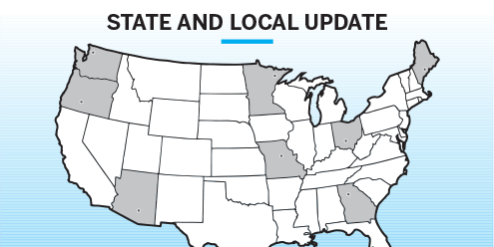AMERICAN MOTORCYCLIST December 2019
State and Local Update

Arizona
Out-of-state residents who want to legally ride their off-highway vehicles in Arizona must buy an OHV decal.
The new decal was approved during the 2019 legislative session and was signed into law by Gov. Doug Ducey.
Money raised through decal sales is to be used for OHV trail maintenance, education and law enforcement efforts.
Both resident and nonresident OHV decals cost $25 (plus a processing fee) and are good for one year from the purchase date.
Those caught riding without a decal may be fined.
Georgia
The Department of Driver Services’ Georgia Motorcycle Safety Program received a $83,464 grant from the Governor’s Office of Highway Safety to help reduce motorcycle fatalities, increase driver awareness of motorcycles and educate motorcycle riders about safety initiatives.
The grant allows the safety program to continue promoting state and national safety initiatives. The GMSP promotes driver awareness of motorcycles on the highways, rider education at 40 locations across the state and motorcycle safety initiatives.
The GMSP operates motorcycle training for new and experienced riders. Classes focus on riding a motorcycle legally and safely.
“We want to ensure everyone has access to proper rider education,” said Holly Hegyesi, GSMP Program Manager. “Motorcycle safety classes are essential for new and experienced riders, alike. Almost one third of motorcycle fatalities involve a rider without a valid license.”
Maine
A battle is brewing in Maine over the use of dirt bikes on trails.
Some members of an ATV task force formed by Gov. Janet Mills want to prohibit motorcycles on trails used by ATVs, UTVs and side-by-sides.
If the task force declines that proposal, a group of Maine residents plans to seek a change in the state law that would remove motorcycles from the legal definition of an ATV. Such a change going into place would effectively prohibit dirt bike use on ATV trails.
The AMA is working with Maine riders and task force members to retain the rights of motorcycle riders in Maine.
The governor’s task force is scheduled to report to the Legislature in January.
Minnesota
A new ATV trail connects the cities of Virginia, Eveleth and Gilbert via the Tom Rukavina Memorial Bridge on state Highway 53.
The 550-foot connector provides a link to the Iron Range Off-Highway Vehicle State Recreation Area in Gilbert.
The state Department of Natural Resources plans to double the size of the OHV park in 2020, and officials expect the number of riders to increase dramatically.
Beth Pierce, Iron Range Tourism director, said ATV riders are “enthusiastic trail explorers who are able and willing to spend money in communities.”
There are an estimated 268,000 registered ATVs in Minnesota.
Iron Range Resources & Rehabilitation provided a Regional Trails grant which helped pay for construction, signage and a culvert for the new connector. Other project partners included Minnesota DNR, the city of Virginia, Iron Range Tourism Bureau and Quad Cities ATV Club.
Missouri
Motorcyclists in Missouri will be required to wear helmets while riding, at least for another year, after the state legislature declined to overrule Gov. Mike Parson’s veto of a bill that would have repealed the current motorcycle helmet law.
Parson cited safety concerns raised by the state Department of Transportation in issuing the veto.
Freedom of the Road Riders supported the bill, which would have provided riders and passengers 18 or older the option of going without a helmet, if they carried health insurance.
Ohio
Four miles of All-Purpose Vehicle trails have been opened at Pike State Forest, according to the Ohio Department of Natural Resources Division of Forestry.
The new trails are on a 144-acre property acquired in 2015 with State Recreational Vehicle funds.
The 4 miles of new trail bring the Pike APV State Forest trail system to nearly 20 miles of trail. The new area includes a designated highway crossing, a two-acre novice riding area, a shelter house with a roof and a kiosk with a trail map.
The SRV fund is made up of APV registration money and is used to support the expansion, development and maintenance of state APV trails. APVs include four-wheelers, dirt bikes, side by sides and dual-sport motorcycles.
Oregon
The Klamath County Board of Commissioners is considering allowing all-terrain vehicles to be driven on county roads.
Officials said people ride ATVs from Klamath County to Idaho. By allowing ATVs on all county roads, more of those people will contribute to the county’s tourism economy. The commissioners planned to devise safety restrictions before approving the proposal.
Washington
The Snohomish County Council voted 4-0 to expand the network of roads where people can legally ride ATVs.
The change affects roads with a speed limit of 35 mph or slower.
Under state law, an ATV rider must wear a motorcycle helmet, unless the ATV has seat belts and roll bars or an enclosed compartment for the operator and passengers.
The state requires safety features such as headlights and turn signals. Operators must be licensed, and their ATVs must be registered.
Several cities in the county allow ATVs on their streets.

